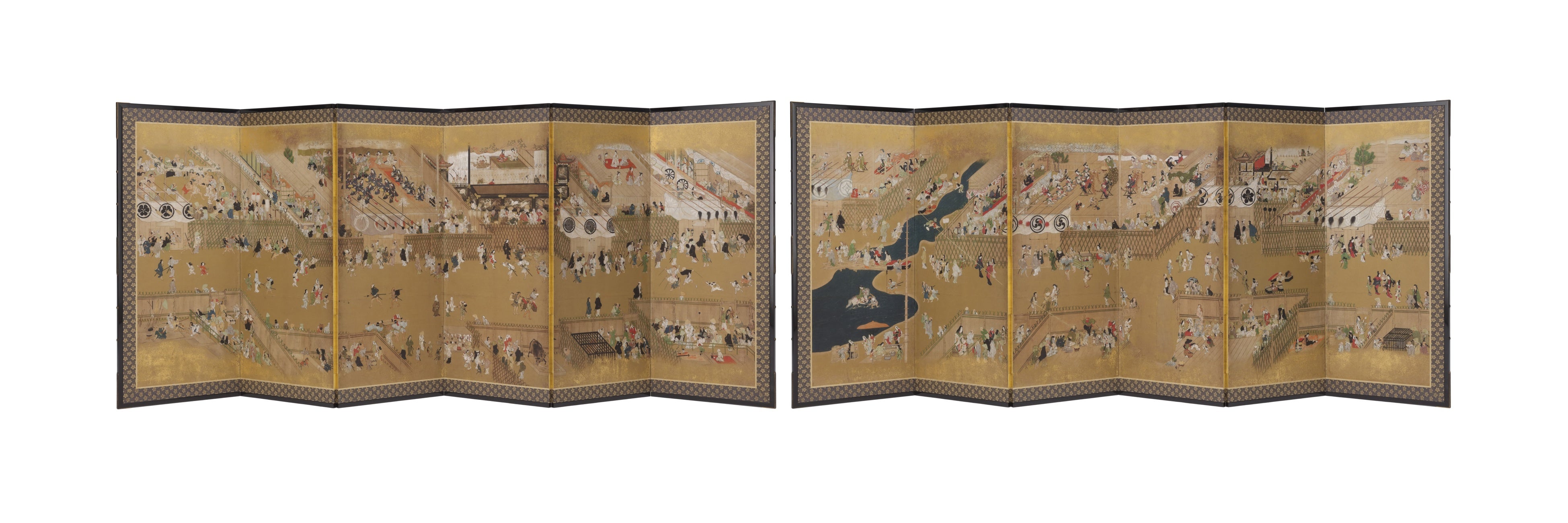
The Tsuzuri Project (formally known as the Project to Inherit Cultural Assets for the Future) is a collaboration between the non-profit organization Kyoto Cultural Association (hereafter referred to as "Kyoto Cultural Association") and Canon Inc. (hereafter referred to as "Canon"). As the 15th work, we created a high-resolution facsimile of the Shijo Kawara-zu folding screen owned by the Museum of Fine Arts, Boston, and donated it to the National Institutes for Cultural Heritage (hereafter, the National Institutes for Cultural Heritage). The donated works will be exhibited from June 6 (Tuesday) to August 27 (Sunday), 2023 at the Tokyo National Museum's interactive exhibition space "Japanese Art Doors".

High-definition facsimile of "Shijo Kawara-zu Byobu" Photograph © 2023 Museum of Fine Arts, Boston. Reproduced with permission.
1. Produced and donated a high-definition facsimile of the Shijo Kawara-zu folding screen owned by the Museum of Fine Arts, Boston
"Shijo Kawahara Folding Screen" is a work that depicts the bustling entertainment district of Kyoto in the Edo period down to the smallest detail. The ground is painted with gold paint (*1) and the clouds are painted with sunago (*2). The original cultural property is in the collection of the Boston Museum of Fine Arts in the United States, and it is a valuable work that has very few opportunities to be seen in Japan.
In producing the high-definition reproduction, the original cultural property was photographed with Canon's full-frame mirrorless camera "EOS R5", image processing was performed using a proprietary color matching system, and 12 colors of pigment were applied. It is printed with a large format inkjet printer loaded with ink. In addition, a traditional Kyoto craftsman applies gold processing to create a folding screen that faithfully reproduces the original cultural property.
In addition, by donating the produced high-definition reproductions to the National Institutes for Cultural Heritage and making them available to the general public, we will create opportunities for many people to become familiar with Japanese cultural properties.
*1. Kindei: A paint made by pulverizing pure gold or near-pure gold and dissolving it in a liquid glue that acts as an adhesive.
*2. Sunago: A Japanese-style painting technique that uses powdered gold and silver foil to create decorations.
2. Exhibiting the donated works in the Tokyo National Museum's hands-on exhibition space "Tobira of Japanese Art"
The donated works will be exhibited from June 6 (Tuesday) to August 27, 2023 ( It will be on display until the day). It is difficult to display original cultural properties without a glass case, and you can appreciate the works up close.
<Summary of the “Tobira of Japanese Art” exhibiting the donated works>
・ Date: June 6 (Tue) to August 27 (Sun), 2023
・ Venue: Tokyo National Museum (13-9 Ueno Park, Taito-ku, Tokyo) Main Building Special Room 3
・Opening hours: 9:30-17:00 (Last entry 30 minutes before closing)
・Closed: Mondays (However, if Monday is a public holiday or holiday, the museum will be open and closed on the following weekday)
In addition, there are temporary closures and temporary openings
・Admission Fee: Tokyo National Museum Comprehensive Cultural Exhibition Admission Fee (1,000 yen for adults, 500 yen for university students)
*The above is subject to change. For the latest information, please check the website of the Tokyo National Museum. https://www.tnm.jp
About the Tsuzuri Project
The Tsuzuri Project is a social contribution activity jointly promoted by the Kyoto Cultural Association and Canon. Many of Japan's ancient and valuable cultural properties have limited opportunities to be appreciated, such as works that have traveled overseas throughout history and works that have been carefully preserved as national treasures. The Tsuzuri Project is a high-definition facsimile that faithfully reproduces the original cultural property by fusing Canon's advanced digital technology for input, image processing, and output with traditional Kyoto craftsmanship. is being produced. The high-definition facsimiles produced are donated to shrines and temples, local governments, and museums that are related to cultural properties, and are used in a variety of settings, such as public exhibitions at the recipients and school education. To date, we have created and donated high-definition reproductions of a total of 57 works, including works by Hokusai Katsushika, Sotatsu Tawaraya, and Korin Ogata.
For details, please refer to the website of "Tsuzuri Project". https://global.canon/en/tsuzuri/
